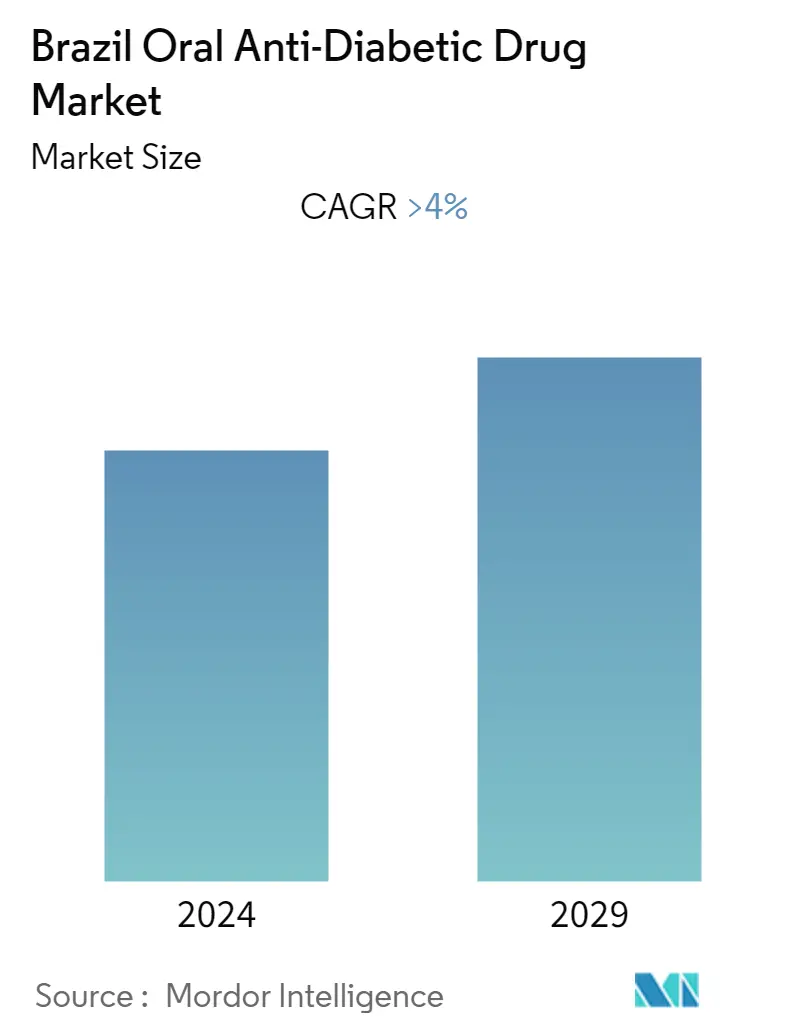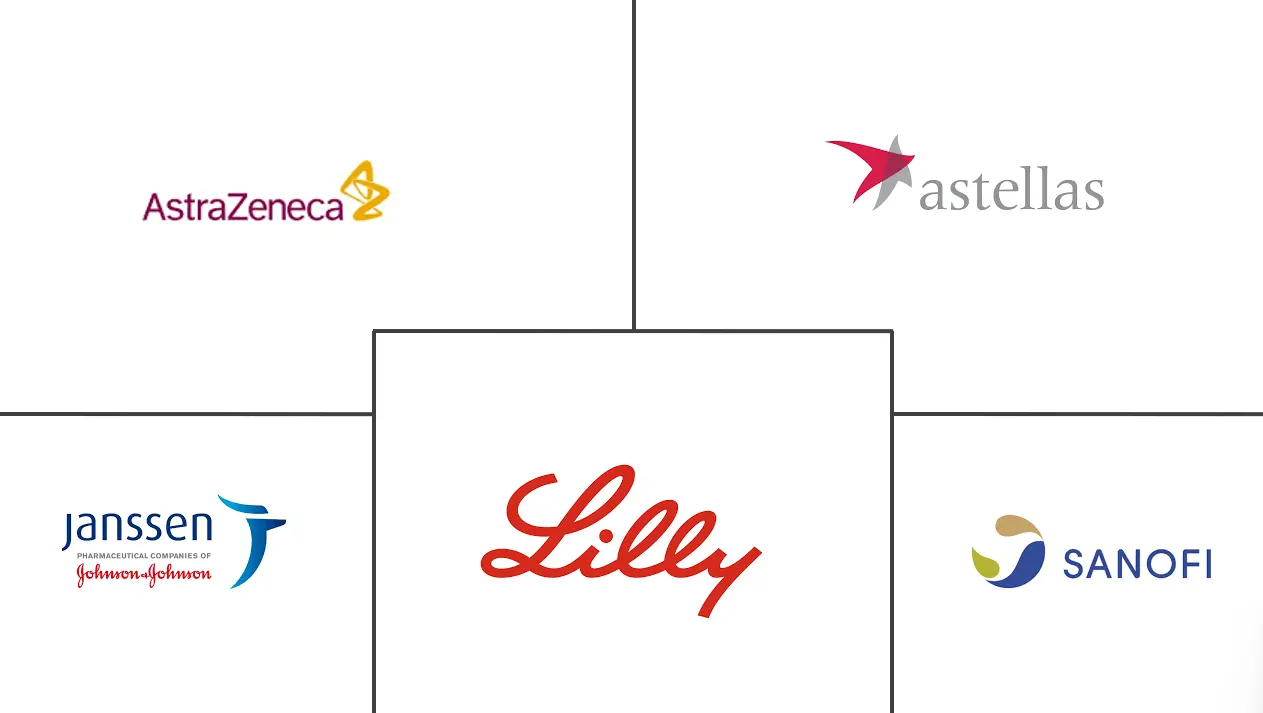Market Size of Brazil Oral Anti-Diabetic Drug Industry

| Study Period | 2019 - 2029 |
| Base Year For Estimation | 2023 |
| Forecast Data Period | 2024 - 2029 |
| Historical Data Period | 2019 - 2022 |
| CAGR | > 4.00 % |
Major Players
*Disclaimer: Major Players sorted in no particular order |
Brazil Oral Anti-Diabetic Drug Market Analysis
The Brazil Oral Anti-Diabetic Drug Market is expected to register a CAGR of more than 4% during the forecast period, with revenue of USD 861 million in the current year.
The COVID-19 pandemic caused early fatalities during the first year of its existence, primarily in older people. Most COVID-19 deaths were caused by co-existing two or more chronic diseases in the same person. Numerous studies established the link between long-term conditions, including diabetes, and unfavorable outcomes in COVID-19 patients. Compared to healthy persons, those with diabetes were more likely to experience significant complications. During COVID-19, the makers of diabetes pharmaceuticals took special care to ensure that diabetic patients received their meds with the assistance of local governments. Drugs known as diabetic medications were created to stabilize and regulate blood glucose levels in people with diabetes. Diabetes patients infected with SARS-CoV-2 during the COVID-19 pandemic may be treated with diabetic medications. The relevance of diabetes treatment medications has been highlighted by the high incidence of diabetes among those hospitalized with COVID-19 infection and the realization that better glycemic management may improve outcomes and shorten hospital stays in COVID-19 patients.
One in ten Brazilian people, or 15.7 million individuals, or roughly 10.5% of the population, have diabetes, according to the IDF Diabetes Atlas 2021. Brazil has the third-highest global diabetes-related health expenditure, costing 42.9 billion USD. Additionally, 18.9% of adults, or 18 million people, have impaired glucose tolerance, which puts them at a greater risk of becoming type 2 diabetes. In Brazil, 32% of people with diabetes are not diagnosed. Only 25% of Brazilians, according to further data on glycaemic management, achieved the treatment target of having an HbA1c of less than 7% before the pandemic, as advised by the Brazilian Diabetes Society (SBD).
Diabetes patients risk significant and even fatal consequences like heart attack, stroke, kidney failure, blindness, and lower limb amputation when undiagnosed or not appropriately controlled. These hurt the quality of life, increase healthcare spending, and make access to treatment more critical. To combat risk factors like obesity and emerging pandemic threats, Brazil has implemented several reforms over the years to improve the distribution of doctors, create new types of service organizations, introduce new financing models, and implement various quality improvement initiatives and policy frameworks. This also shows areas where improvements in how diabetes treatment is provided may be expanded and continued.
Brazil Oral Anti-Diabetic Drug Industry Segmentation
Orally administered antihyperglycemic drugs reduce blood glucose levels. They are often used in type 2 diabetes care. Brazil's Oral Anti-Diabetic Drug Market is set to witness a CAGR of more than 4% during the forecast period. Brazil Oral Anti-Diabetic Drug Market is segmented into drugs (Biguanides, Alpha-glucosidase inhibitors, Dopamine-D2 receptor agonists, Sodium-glucose Cotransport-2 (SGLT-2) inhibitor, Dipeptidyl Peptidase-4 (DPP-4) Inhibitors, Sulfonylureas, and Meglitinides). The report offers the value (in USD million) and volume (in Units million) for the above segments.
| Oral Anti-diabetic drugs | ||||||
| ||||||
| ||||||
| ||||||
| ||||||
| ||||||
| ||||||
|
Brazil Oral Anti-Diabetic Drug Market Size Summary
The Brazil Oral Anti-Diabetic Drug Market is poised for growth, driven by the increasing prevalence of diabetes and the need for effective management solutions. The market is characterized by a significant focus on oral medications, which are preferred due to their ease of use and cost-effectiveness compared to insulin therapies. The sulfonylurea segment is expected to lead the market, benefiting from its affordability and widespread acceptance among healthcare providers. The Brazilian government's initiatives to enhance access to diabetes medications, coupled with collaborations with private sectors to ensure affordable pricing, are anticipated to further propel market expansion. The COVID-19 pandemic underscored the importance of diabetes management, as patients with uncontrolled diabetes faced higher risks of severe complications, thereby highlighting the critical role of oral anti-diabetic drugs in improving patient outcomes.
The Brazilian healthcare system, particularly the Sistema √önico de Sa√∫de (SUS), plays a pivotal role in providing access to oral anti-diabetic medications, funding a substantial portion of these drugs. However, the shift of consumers from SUS Health Units to Popular Pharmacies indicates a need for restructuring to maintain continuity in diabetes care. The government's Strategic Action Plan aims to enhance access to essential health services and medications, addressing the rising burden of non-communicable diseases. The market is consolidated, with major global players like Eli Lilly, AstraZeneca, Sanofi, and Janssen Pharmaceuticals leading the charge, while local manufacturers focus on regional markets. Innovations in diabetes treatment, such as Oramed's oral insulin capsule and Eurofarma's Suganon, are expected to reshape the landscape, offering new avenues for managing diabetes effectively in Brazil.
Brazil Oral Anti-Diabetic Drug Market Size - Table of Contents
-
1. MARKET DYNAMICS
-
1.1 Market Overview
-
1.2 Market Drivers
-
1.3 Market Restraints
-
1.4 Porter's Five Forces Analysis
-
1.4.1 Bargaining Power of Suppliers
-
1.4.2 Bargaining Power of Consumers
-
1.4.3 Threat of New Entrants
-
1.4.4 Threat of Substitute Products and Services
-
1.4.5 Intensity of Competitive Rivalry
-
-
-
2. MARKET SEGMENTATION
-
2.1 Oral Anti-diabetic drugs
-
2.1.1 Biguanides
-
2.1.1.1 Metformin
-
-
2.1.2 Alpha-Glucosidase Inhibitors
-
2.1.2.1 Alpha-Glucosidase Inhibitors
-
-
2.1.3 Dopamine D2 receptor agonist
-
2.1.3.1 Bromocriptin
-
-
2.1.4 SGLT-2 inhibitors
-
2.1.4.1 Invokana (Canagliflozin)
-
2.1.4.2 Jardiance (Empagliflozin)
-
2.1.4.3 Farxiga/Forxiga (Dapagliflozin)
-
2.1.4.4 Suglat (Ipragliflozin)
-
-
2.1.5 DPP-4 inhibitors
-
2.1.5.1 Onglyza (Saxagliptin)
-
2.1.5.2 Tradjenta (Linagliptin)
-
2.1.5.3 Vipidia/Nesina(Alogliptin)
-
2.1.5.4 Galvus (Vildagliptin)
-
-
2.1.6 Sulfonylureas
-
2.1.6.1 Sulfonylureas
-
-
2.1.7 Meglitinides
-
2.1.7.1 Meglitinides
-
-
-
Brazil Oral Anti-Diabetic Drug Market Size FAQs
What is the current Brazil Oral Anti-Diabetic Drug Market size?
The Brazil Oral Anti-Diabetic Drug Market is projected to register a CAGR of greater than 4% during the forecast period (2024-2029)
Who are the key players in Brazil Oral Anti-Diabetic Drug Market?
Astrazeneca, Astellas, Janssen, Eli Lilly and Sanofi are the major companies operating in the Brazil Oral Anti-Diabetic Drug Market.

